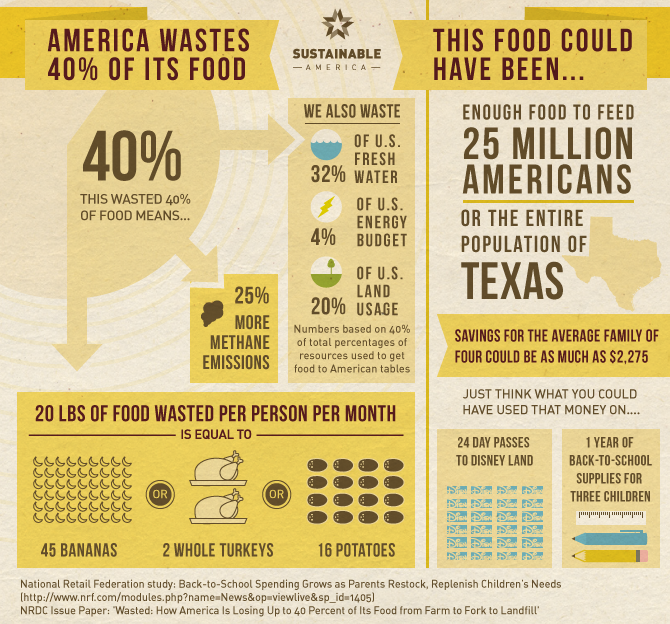40% of food available to Americans is discarded, and most of that uneaten food ends up rotting in landfills. A new report by the NRDC (Natural Resources Defense Council) has compiled many existing statistics to demonstrate the magnitude of food waste in the U.S.

According to the NRDC website,
>Getting food to our tables eats up 10 percent of the total U.S. energy budget, uses 50 percent of U.S. land, and swallows 80 percent of freshwater consumed in the United States. Yet, 40 percent of food in the United States today goes uneaten. That is more than 20 pounds of food per person every month. Not only does this mean that Americans are throwing out the equivalent of $165 billion each year, but also 25 percent of all freshwater and huge amounts of unnecessary chemicals, energy, and land.
America is facing a potential food / fuel crisis, not to mention water shortages, and food insecurity, so this isn’t just a matter of wasting one’s own time and money on discarded food. All of this waste adds up to American land, energy and water being wasted needlessly every day.
This massive amount of food waste is particularly glaring at a time when so many Americans are going hungry. The NRDC says,
>Nutrition is also lost in the mix – food saved by reducing losses by just 15 percent could feed more than 25 million Americans every year at a time when one in six Americans lack a secure supply of food to their tables.
According to the NRDC report, American families throw out approximately 25 percent of the food and beverages they buy. They estimate the cost of that waste for the average family of four is $1,365 to $2,275 annually.
The good news is that there are solutions to food waste. While food waste happens at every level of the food supply chain, consumers can avoid food waste on the front end by thinking through quantity when they purchase their food, and possibly save that 25 percent of food and beverages by reducing waste.
Use the following tips to save money and resources.
+ Plan meals, make a grocery list, and avoid impulse shopping at the grocery store. An easy rule of thumb, don’t go grocery shopping when you’re hungry!
+ Understand expiration dates. “Sell by” and “use by” dates are not federally regulated and do not indicate safety,
except on certain baby foods. They are simply manufacturer suggestions for peak quality. Many foods can be safely
consumed after their “sell by” and “use by” dates.
+ Eat your leftovers or prepare smaller portions. Replate and Go Halfsies are two innovative concepts related to portion control.
+ Turn appropriate spoiled foods and scraps into compost to use on your lawn, garden, or houseplants.
There is no downside to minimizing food waste. Start saving today for a fatter wallet and a more Sustainable America!
